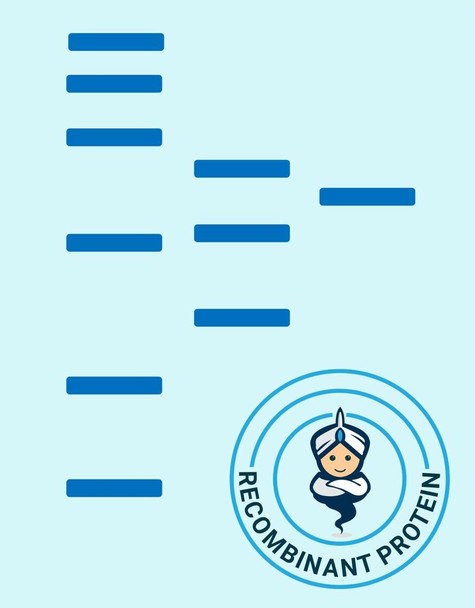Human TULP1 Recombinant Protein (RPPB5041)
- SKU:
- RPPB5041
- Product Type:
- Recombinant Protein
- Species:
- Human
- Uniprot:
- O00294
Description
| Product Name: | Human TULP1 Recombinant Protein |
| Product Code: | RPPB5041 |
| Size: | 20µg |
| Species: | Human |
| Target: | TULP1 |
| Synonyms: | Tubby like protein 1, TUBL1, RP14, LCA15, tubby-related protein 1. |
| Source: | Escherichia Coli |
| Physical Appearance: | Sterile Filtered colorless solution. |
| Formulation: | The TULP1 solution (1mg/1ml) contains 20mM Tris-HCl buffer (pH 8.0), 0.2M NaCl, 5mM DTT, 2mM EDTA and 50% glycerol. |
| Stability: | Store at 4°C if entire vial will be used within 2-4 weeks. Store, frozen at -20°C for longer periods of time. For long term storage it is recommended to add a carrier protein (0.1% HSA or BSA).Avoid multiple freeze-thaw cycles. |
| Purity: | Greater than 90% as determined by SDS-PAGE. |
| Amino Acid Sequence: | MGSSHHHHHH SSGLVPRGSH MGSEPREFVL RPAPQGRTVR CRLTRDKKGM DRGMYPSYFL HLDTEKKVFL LAGRKRKRSK TANYLISIDP TNLSRGGENF IGKLRSNLLG NRFTVFDNGQ NPQRGYSTNV ASLRQELAAV IYETNVLGFR GPRRMTVIIP GMSAENERVP IRPRNASDGL LVRWQNKTLE SLIELHNKPP VWNDDSGSYT LNFQGRVTQA SVKNFQIVHA DDPDYIVLQF GRVAEDAFTL DYRYPLCALQ AFAIALSSFD GKLACE |
Tubby-related protein 1 (TULP1) belongs to the TULP family of 4 proteins (TUB and TULP1, -2, and -3), categorized structurally by the highly conserved C-terminal half of the protein. Tubby-like gene family (TULPs) members are found in plants, vertebrates, and invertebrates and encode proteins of unknown function. TULP proteins share a conserved C-terminal region of roughly 200 amino acid residues. In the retina, TULP1 is observed exclusively in the photoreceptor cells, localizing predominantly in the inner segments and connecting cilium and to a lesser degree in the perinuclear cytoplasm and synaptic termini. TULP1 gene mutations are linked with retinitis pigmentosa.
TULP1 Human Recombinant produced in E. coli is a single polypeptide chain containing 276 amino acids (290-542) and having a molecular mass of 31.1 kDa.TULP1 is fused to a 23 amino acid His-tag at N-terminus & purified by proprietary chromatographic techniques.
| UniProt Protein Function: | TULP1: Required for normal development of photoreceptor synapses. Required for normal photoreceptor function and for long- term survival of photoreceptor cells. Interacts with cytoskeleton proteins and may play a role in protein transport in photoreceptor cells. Binds lipids, especially phosphatidylinositol 3-phosphate, phosphatidylinositol 4- phosphate, phosphatidylinositol 5-phosphate, phosphatidylinositol 3,4-bisphosphate, phosphatidylinositol 4,5-bisphosphate, phosphatidylinositol 3,4,5-bisphosphate, phosphatidylserine and phosphatidic acid (in vitro). Contribute to stimulation of phagocytosis of apoptotic retinal pigment epithelium (RPE) cells and macrophages. Defects in TULP1 are the cause of retinitis pigmentosa type 14 (RP14). RP leads to degeneration of retinal photoreceptor cells. Patients typically have night vision blindness and loss of midperipheral visual field. As their condition progresses, they lose their far peripheral visual field and eventually central vision as well. RP14 inheritance is autosomal recessive. Defects in TULP1 are the cause of Leber congenital amaurosis type 15 (LCA15). LCA15 is a severe dystrophy of the retina, typically becoming evident in the first years of life. Visual function is usually poor and often accompanied by nystagmus, sluggish or near-absent pupillary responses, photophobia, high hyperopia and keratoconus. Belongs to the TUB family. 2 isoforms of the human protein are produced by alternative splicing.Protein type: CytoskeletalChromosomal Location of Human Ortholog: 6p21.3Cellular Component: cell projection; cilium; photoreceptor inner segment; photoreceptor outer segment; plasma membrane; synapseMolecular Function: actin filament binding; phosphatidylinositol-4,5-bisphosphate binding; protein bindingBiological Process: dendrite development; detection of light stimulus involved in visual perception; eye photoreceptor cell development; photoreceptor cell maintenance; positive regulation of phagocytosis; retinal homeostasis; visual perceptionDisease: Leber Congenital Amaurosis 15; Retinitis Pigmentosa 14 |
| UniProt Protein Details: | |
| NCBI Summary: | This gene encodes a member of the tubby-like gene family (TULPs). Members of this family have been identified in plants, vertebrates, and invertebrates and encode proteins of unknown function. TULP proteins share a conserved C-terminal region of approximately 200 amino acid residues. Mutations in this gene may be associated with juvenile retinitis pigmentosa and Leber congenital amaurosis-15. Alternative splicing results in multiple transcript variants. [provided by RefSeq, Jan 2014] |
| UniProt Code: | O00294 |
| NCBI GenInfo Identifier: | 206729948 |
| NCBI Gene ID: | 7287 |
| NCBI Accession: | O00294.3 |
| UniProt Secondary Accession: | O00294,O43536, Q5TGM5, Q8N571 |
| UniProt Related Accession: | O00294 |
| Molecular Weight: | 54,667 Da |
| NCBI Full Name: | Tubby-related protein 1 |
| NCBI Synonym Full Names: | tubby like protein 1 |
| NCBI Official Symbol: | TULP1�� |
| NCBI Official Synonym Symbols: | RP14; LCA15; TUBL1�� |
| NCBI Protein Information: | tubby-related protein 1 |
| UniProt Protein Name: | Tubby-related protein 1 |
| UniProt Synonym Protein Names: | Tubby-like protein 1 |
| Protein Family: | Tubby-related protein |
| UniProt Gene Name: | TULP1�� |
| UniProt Entry Name: | TULP1_HUMAN |










